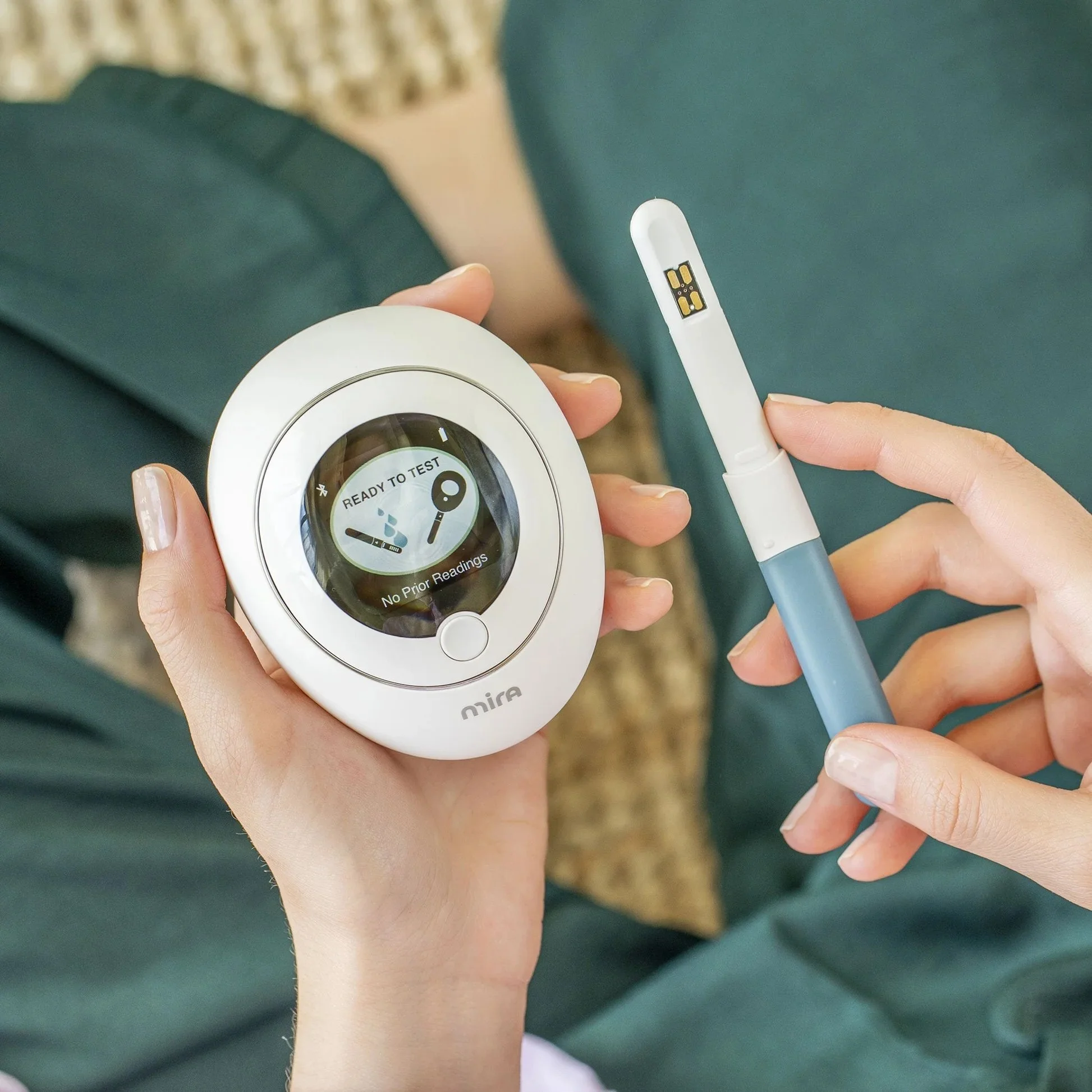The Rise of Hormone Testing: What Works—and What’s Hype
In just the past couple of years, hormone testing options have exploded—from a niche wellness tool to a mainstream trend. Scroll through social media and you’ll see women posting their “hormone balancing” routines, cycle charts, saliva swabs, and app dashboards tracking every hormonal rise and fall. It’s exciting to see more people paying attention to their health—but without the right context and guidance, testing can be confusing and even misleading.
In this post, we’ll cut through the noise to explain what these tests actually measure, which ones are worth the investment, and when this level of testing can truly move the needle for your health.
What Is Hormone Testing?
Hormone testing measures the chemical messengers that regulate everything from your mood and energy to your fertility and metabolism. These tests can be done through blood, saliva, urine, or at-home devices, and they help identify suboptimal levels that may be contributing to symptoms like fatigue, irregular cycles, fertility issues, mood changes, or skin problems. Here are some of the most common methods:
Blood tests – The most common in medical settings, providing a snapshot of hormone levels at one point in time. This can include:
Bound hormones – Attached to proteins like SHBG (sex hormone–binding globulin) or albumin, which carry them through the bloodstream but make them temporarily inactive (e.g., most estrogen and testosterone in blood are bound).
Unbound hormones – Also called free or bioavailable hormones, which are active and able to bind to receptors to have an effect in the body (e.g., free T3 and free testosterone).
At-home fluorescent-based devices, like Mira – Mira is a device that allows you to track hormones at home using urine-based test wands. Instead of giving you just a single-day snapshot, Mira measures your levels across your entire cycle, producing a complete hormonal map. The system tracks LH (luteinizing hormone), E3G (estrone-3-glucuronide, a form of estrogen), PdG (pregnanediol glucuronide, a progesterone metabolite), and FSH (follicle-stimulating hormone). Together, these provide insight into ovulation, fertile windows, and cycle irregularities. The results sync directly with the Mira app, which graphs your hormonal patterns, provides fertility predictions, and helps you better understand how hormone shifts may connect to your symptoms—all without having to schedule a blood draw.
Saliva testing – Measures the bioavailable (unbound) fraction of hormones—the form your body can actually use. Hormometer, for example, is a new and popular saliva test. This can give a clear picture of present, active hormone levels; however, saliva testing does not measure bound hormones or carrier proteins, like SHBG, which play an important role in regulating how much hormone is available. Without that bound hormone data, you may miss valuable insight into why active levels are high or low.
Urine-based testing (DUTCH Test) – The DUTCH test collects dried urine samples over 24 hours to measure hormone production and how your body metabolizes them. It also maps daily cortisol patterns and provides a mini organic acids panel for nutrients like B12 and B6. This deeper insight into hormone clearance, detoxification, and balance can reveal estrogen metabolism patterns, some linked to higher risk for hormone driven cancers, so you can take steps to support safer pathways.
Why Test Hormones?
Before you click ‘buy’ on the latest home hormone kit, it’s important to understand what these tests can (and can’t) reveal. When used strategically, they can help uncover contributing factors to:
Irregular cycles or suspected PCOS
Unexplained weight changes
Painful, heavy periods or endometriosis
Acne or other skin changes linked to hormones
Fertility challenges or perimenopause symptoms
Chronic fatigue, sleep disturbances, or mood swings
The key is working with a trusted health professional to choose the right test for your situation and to interpret results in a way that leads to clear, effective next steps. Without that context, results can be confusing or misleading.
A Real-Life Example
One of our clients came to us six months after stopping birth control. Her cycle hadn’t returned, she was dealing with acne, poor digestion, and a lot of anxiety about her health. Like many women, she had tried piecing together advice online, but nothing was working.
We ran comprehensive hormone and nutrient tests, began tracking her cycle, and put together a plan that included diet changes, detoxification support, targeted supplements, and lifestyle shifts. Within three months her cycle returned, her skin cleared, her energy improved, and her confidence grew. With her body back in balance, she was able to start preparing for pregnancy from a healthier place.
Her story shows what’s possible when hormone testing is paired with expert guidance and a whole-body approach: numbers become actionable steps and symptoms start to resolve naturally.
The Social Media Buzz…And When to be Cautious
It’s no secret that hormone testing has become a wellness trend online. Influencers frequently post their results and routines, often without the clinical context to back them up. Many tests you can order online aren’t comprehensive, may not be the right fit for your situation, and often leave you without the support you need to turn results into a real plan.
At GreenMind Health, we take a different approach:
We look at the whole picture and conduct a comprehensive review of your health history and symptoms before jumping to in-depth testing.
Many symptoms of hormone imbalances are actually signs of deeper problems—especially gut health issues and dysbiosis (an imbalance of bacteria in your gut). Research has found that there’s a bidirectional relationship with the gut microbiome and sex hormones’ influence on one another (He et al., 2021).
We start with foundational habits—balanced nutrition, blood sugar regulation, stress management, and quality sleep—because these alone often help restore healthy hormone function without the need for advanced testing. Many clients come to us feeling like they’ve “tried everything,” but still have hidden habits that work against them—like undereating, overdoing cardio, or stressing so much about their health that it becomes yet another burden on their body.
In many cases, comprehensive blood lab work is enough to start, then more extensive hormone test options can be layered in if indicated.
Breaking Down the Testing Options
Our approach is simple: start with foundational habits, gut health support, and a comprehensive lab analysis—then go deeper as needed. Here’s how we use the main testing tools in our practice at GreenMind:
Comprehensive blood work
Many hormone blood tests focus only on thyroid or a small handful of sex hormones. For example, it’s common to check TSH (thyroid stimulating hormone) when assessing thyroid health, but that doesn’t reveal how well your body is converting it to the active thyroid hormone, T3. While this can be a starting point, it misses how different systems in the body influence each other.
At GreenMind, we take a more integrative approach. Our comprehensive blood work looks at hormone levels alongside cardiovascular markers, metabolic health, and nutrient status—because all of these are interconnected. For example, low iron can impair thyroid function, and poor blood sugar control can disrupt reproductive hormones. Elevated insulin (hyperinsulinemia) can even trigger the ovaries to produce more androgens like testosterone (Unluhizarci et al., 2021), contributing to conditions such as PCOS.
Our panels may include estradiol, progesterone, testosterone, AM cortisol, a complete thyroid panel, fasting insulin, lipid markers, and key nutrients like vitamin D, B vitamins, and iron status. This approach helps us see patterns, identify root causes, address nutrient deficiencies, and design a plan that supports your whole-body health—not just a few numbers on a lab report.
GI Testing (GI-MAP)
It may seem unrelated, but gut health is a cornerstone of hormone balance, especially if we suspect gut-driven inflammation, dysbiosis (an imbalance of beneficial and harmful bacteria), or digestive issues that may be affecting hormone balance. The GI-MAP uses advanced DNA-based technology to assess the gut microbiome, detect pathogens, and measure digestive and immune markers.
Gut health plays a direct role in hormone metabolism, particularly estrogen. Certain gut bacteria produce an enzyme called β-glucuronidase, which can reactivate estrogen that the body is trying to eliminate. This reactivation can raise circulating estrogen levels, and research suggests that changes in the gut microbiome may play a role in developing estrogen-related diseases like ovarian cancer (He et al., 2021).
By identifying microbial imbalances, infections, or inflammatory patterns, GI testing can help explain why hormones aren’t metabolizing or clearing properly. This allows us to create a targeted plan—addressing gut health first—so that hormonal therapies and lifestyle changes work more effectively.
Mira (Fluorescent Technology)
Our favorite at-home cycle tracking device, Mira measures four key hormones across your entire cycle—not just on a single day—providing a month-long view of your hormonal shifts. This longer window can reveal subtle changes that one-day tests often miss, making it a valuable tool for supporting fertility, monitoring hormonal trends over time, and gaining a clearer picture “under the hood,” particularly for women with irregular cycles or unpredictable ovulation.
DUTCH Test (Urine)
The DUTCH Test provides insight you can’t get from blood or saliva alone. By collecting dried urine samples over 24 hours, it shows how your body is both producing and breaking down hormones. One of the most valuable pieces of this test is its map of estrogen metabolites—the different “breakdown products” your body makes when it processes estrogen. Some pathways are considered healthier and less likely to trigger cell changes, while others may be linked to a higher risk of hormone-sensitive cancers like breast cancer (Brantley et al., 2025). Understanding how your body is processing and clearing hormones can help guide nutrition, lifestyle, and supplement strategies to support healthy estrogen metabolism. We often recommend DUTCH testing when we need a deeper understanding of hormone metabolism or when there’s a family history of breast or other hormone-sensitive cancers.
The Bottom Line
Hormone testing can be incredibly valuable, but on its own it’s not a magic bullet—its real power comes from in-depth interpretation and a strong, clinically guided plan for what to do with the results.
An experienced practitioner can:
Interpret results in the context of your symptoms, lifestyle, and other lab data.
Help you decide which test is actually worth running for you specifically.
Turn numbers into an actionable plan—covering diet, supplements, and lifestyle strategies.
If you’re curious about whether hormone testing is right for you—or you want a plan to address your symptoms—book a complimentary consult call with our team. We’ll help you get clear on what’s going on in your body and create a path forward that works in real life.
Sources
Brantley, K. D., Ziegler, R. G., Craft, N. E., Hankinson, S. E., & Eliassen, A. H. (2025). Circulating estrogen metabolites and risk of breast cancer among postmenopausal women in the Nurses' Health Study. Cancer Epidemiology, Biomarkers & Prevention: A Publication of the American Association for Cancer Research, Cosponsored by the American Society of Preventive Oncology, 34(3), 375–384. https://doi.org/10.1158/1055-9965.EPI-24-0577
He, S., Li, H., Yu, Z., Zhang, F., Liang, S., Liu, H., Chen, H., & Lü, M. (2021). The gut microbiome and sex hormone-related diseases. Frontiers in Microbiology, 12, 711137. https://doi.org/10.3389/fmicb.2021.711137
Unluhizarci, K., Karaca, Z., & Kelestimur, F. (2021). Role of insulin and insulin resistance in androgen excess disorders. World Journal of Diabetes, 12(5), 616–629. https://doi.org/10.4239/wjd.v12.i5.616




